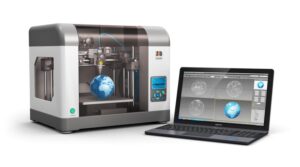3D Printing
Though 3D printing may seem like a futuristic concept, the technology has been around for over 30 years.
Chuck Hull created the first 3D-printing process in 1983. It was called “stereolithography”. The process was described as a “method or apparatus to make solid objects by successively printing thin layers of ultraviolet curable materials one on top the other”. Hull’s patent only covers ‘printing with light curable liquids’. However, after founding the company 3D Systems, Hull realized that his technique wasn’t limited to liquids. He expanded the definition to include ‘any material that can solidify or change its physical state.’ This is what Hull did to lay the foundation for additive manufacturing, or 3D printing.

3D Printing
The process of 3D printing involves the creation of solid three-dimensional objects using a digital model. This process is the opposite of subtractive manufacture, which involves cutting out or hollowing a piece metal or plastic using a milling device. Additive processes are used to create 3D printed objects. Layers of material are laid down until an object is formed. This allows manufacturers to create complex shapes and functional objects using less material than conventional manufacturing methods.
No matter what industry or profession you are in, 3D Printing can be beneficial. The finished product must perform as expected in order to be useful. The printer must adhere to exact parameters. For this to happen, the equipment used to layer and cut the materials must be highly precise and sensitive. SUPERIOR® Optics works with your team in order to provide a precision lens that will ensure the final product is cut and layered exactly as you intended.
3D printing is now used in many different sectors.
Automotive Industry:
The automotive industry is not new to 3D printing, both for prototypes and finished parts. Many Formula 1 racing teams use 3D printing to prototype, test and create custom car parts used in competitive races.
Medical Community:
Did you know the majority of hearing aids today are 3D-printed? The adoption of 3D printers has been a major benefit to the medical and prosthetics fields. With 3D printing, custom shapes like hearing aids can be produced with a click of a mouse. The result is a significant reduction in production costs and times.
The e-NABLE hand prosthetic is perhaps one of the best examples of 3D printing revolutionizing medicine. This free, easy-to-make 3D-printed prosthetic hand was designed for children who need a prosthetic device. These devices can be expensive when produced using conventional manufacturing methods.
Architecture:
Creating scale models before the advent of 3D printers in the field of Architecture was a time-consuming and laborious process. It was essential for architects to convey their design intention. Now, independent and large architectural firms can create 3D scale models directly from the CAD data they use to develop blueprints. These 3D models can be produced in a variety of materials and colors, depending on the level of communication desired.
Aerospace:
The International Space Station produced a ratchet in 2014. This was perhaps the most notable use of 3D Printing. “If you are able to send a file as quickly as an email to the station, you will have endless possibilities to make everything from CubeSats to experiment hardware. We may even be able make objects that couldn’t be launched into space before.”, said Niki Workheiser, NASA’s Marshall Space Flight Center’s 3-D printer program director in Huntsville, Alabama.
Some additive manufacturing supporters predict that this technological advancement will change the nature and scope of commerce because end users will have more freedom to manufacture their own products rather than relying on trade to purchase goods from others.
Existing 3D printers that can output in color, multiple materials and with ease will continue to develop until they reach a stage where electronic products (functional) will be possible to produce. 3D printing has a huge impact on the manufacturing industry. It will affect energy usage, waste reduction and customization, as well as product availability.
Related Posts
Machine Vision Technology
How useful was this post? Click on a star to rate it! Submit Rating As you found this post useful......
Hole Inspection With Machine Vision
How useful was this post? Click on a star to rate it! Submit Rating As you found this post useful......




